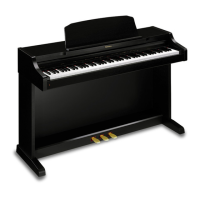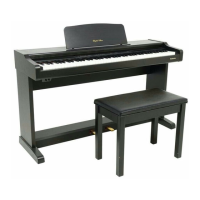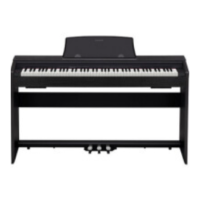
Do you have a question about the Technics SX-PX663 and is the answer not in the manual?
| Type | Digital Piano |
|---|---|
| Keyboard | 88-key |
| Keys | 88 |
| Polyphony | 64 notes |
| Tones | 16 |
| Effects | Reverb, Chorus |
| Built-in Speakers | Yes |
| MIDI | Yes |
Explains instrument setup and basic playing knowledge.
Details sound, effect, rhythm, sequencer, disk drive, and MIDI.
Refers to a separate booklet for detailed content.
Covers risks of fire, electric shock, and product damage.
Guidelines for power source, polarization, and periods of non-use.
Advice on water, moisture, cart/stand, ventilation, heat, and foreign material.
Warning regarding potential hearing loss from high volume levels.
Instructions for servicing, maintenance, and cleaning the unit.
Steps for plugging in, turning on the power, and playing the keyboard.
Instructions on how to open and close the keyboard cover.
Guidance on inserting the music stand into the designated holes.
Notes that the digital piano does not require tuning but pitch can be adjusted.
How to activate and listen to grand piano demonstration tunes.
How to select and listen to demonstration tunes for other sounds.
Method to play all demonstration tunes in order.
Selecting sounds, Touch Response, and mixing multiple sounds.
Details on applying reverb and digital effects to sounds.
Explanation of sostenuto and soft pedal functions.
Adjusting sound brightness and keyboard touch response.
Notes that effect settings are stored independently for each sound.
Describes the display's role in showing settings and tempos.
Introduces the sequencer for storing and playing back performances.
Step-by-step instructions for recording the first track.
Step-by-step instructions for recording the second track.
Details on storage capacity, error handling, and metronome use.
How to play back recorded tracks and adjust playback speed.
Instructions on how to delete recorded tracks from the sequencer.
How to select and produce the nine different organ sounds.
How to play two sounds simultaneously and adjust volume balance.
How to use transpose buttons to change the song's key.
Procedure to adjust the instrument's pitch for ensemble playing.
How to select reverb types and adjust their depth.
How to adjust the sympathetic string resonance effect.
Turning on the metronome and adjusting tempo.
How to adjust the volume of the metronome sound.
Selecting time signatures and adding accents to beats.
Details piano tuning and minimum range settings.
How to change instrument functions using panel buttons.
How to return all settings to their default status.
Explains MIDI IN/OUT ports and types of data transmitted/received.
How to assign a MIDI channel (1-16) to the instrument.
Details MIDI functions like MULTI TIMBRE, OMNI ON, PROGRAM CHANGE.
Shows the relationship between keyboard notes and MIDI note numbers.
How to transmit desired PROGRAM CHANGE numbers to connected instruments.
Details PEDAL IN, AUX IN, and LINE OUT terminal connections.
Instructions for connecting headphones for silent practice.
Lists phenomena like no sound, display issues, and MIDI problems with solutions.
Detailed instructions for assembling the piano body and stand.
Confirms parts, stability, connections, and secures the piano body.
Explains how settings and sequencer contents are retained in memory.
Details MIDI functions, transmitted/recognized data, and remarks.
Lists detailed technical specifications for SX-PX662 and SX-PX664.
Lists all demo songs for PX662 and PX664 with their composers.











